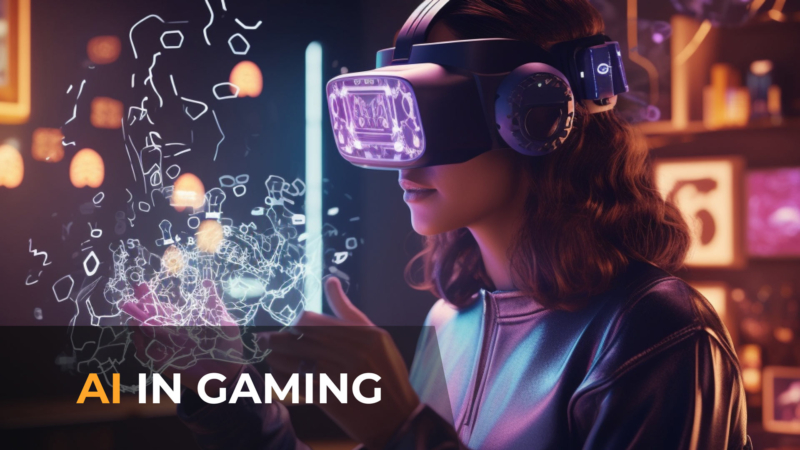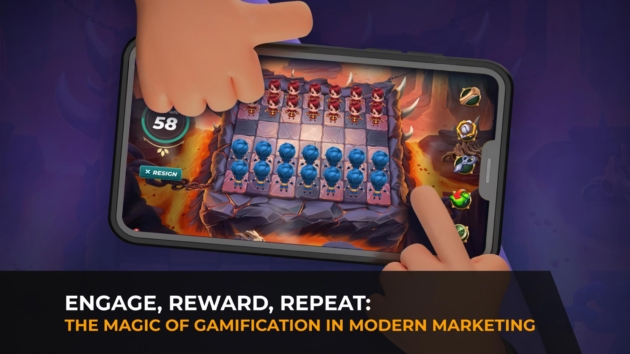Artificial Intelligence (AI) of various types has already made its way into multiple industries. In modern game development, it helps engineers enhance various aspects of the player’s experience. In this article, we describe several key ways Stepico utilizes AI technologies to enhance, streamline, and optimize engineering and testing in custom, web, and mobile game development.
AI in Gaming Development is an Effective Tool for Non-Player Character (NPC) Behavior Generation
We employ neural networks to convert text into speech (Text-to-Speech, TTS) and speech into text (Speech-to-Text, STT) in our gaming systems, enhancing the realism and interactivity of interactions with non-playable characters (NPCs).
This allows us to give our NPCs unique vocal characteristics, contributing to a more immersive player experience within the video game world. NPCs can “listen” and comprehend vocal commands or dialogues from players. This creates an opportunity for natural communication with NPCs, where players can use their voice to interact with the surrounding environment, pose questions, or even influence the storyline through verbal decisions.
Pathfinding
The first aspect we are going to mention is goal-oriented pathfinding. Specifically, we often employ AI algorithms to enable NPCs to navigate the game efficiently. These algorithms take into account obstacles and dynamically adjust paths based on the changing game environment.
Decision-making
The next thing is decision-making. In particular, we mean Finite State Machines (FSM) and Behavior Trees, which define the patterns of behavior of NPCs. These structures help simulate decision-making processes, allowing NPCs to respond intelligently to player actions, environmental changes, or specific in-game events.
Adaptive Artificial Intelligence
Another important tool is adaptive AI. In some games, we incorporate adaptive AI that learns from player behavior. These algorithms analyze player actions and adjust NPC performance over time to provide a more challenging and responsive gaming experience.
Emotional Artificial Intelligence
We also use AI for emotion simulation. Advanced AI-powered systems simulate emotional states for NPCs, affecting what they do in the game. This adds a layer of realism to the title, making interactions with NPCs more immersive for players.
Interactive Dialogue in a Game
A game developer can leverage natural language processing (NLP) algorithms to create dynamic and context-aware dialogues for NPCs. This allows NPCs to respond intelligently to player input, making in-game conversations more natural and engaging.
Voice Recognition
NLP powers voice recognition systems in some titles, allowing players to control characters, issue commands, or engage in conversations using spoken language. This technology enhances the overall user experience and provides a more natural way for players to interact with the game.
Uncommon Actions with Artificial Intelligence
A game developer can employ adversarial agents programming to imitate human-like behavior for NPCs, such as bluffing, reacting to unexpected events, or adapting to different playstyles.
How AI is used the Gaming Industry for Procedural Content Generation (PCG)
The use of GPT models in these areas of game development simplifies and automates processes, ensuring more efficient content creation, personalized gameplay, and more engaging game worlds for players.
Terrain and Level Design
Procedural content generation is widely used to create diverse game worlds. AI algorithms are great at generating terrain, landscapes, and level layouts, and thus they can help us ensure that each playthrough offers a unique experience. This is particularly common in open-world and roguelike games.
Quests and Missions
AI models are also able to dynamically generate quests, missions, and objectives based on various factors such as player progress, choices, and in-game events. If utilized this way, AI models allow engineers to add variety and replayability to the game.
Asset Generation
Predictive models can also assist us in creating textures, models, and other visual assets for the game. Generative tools, such as Dall-E and Midjourney, can create diverse and realistic content, reducing the burden on artists and enabling the rapid creation of expansive game worlds.
Storyline and Narrative
AI is employed to generate storylines and narratives, creating branching paths and multiple outcomes based on player choices. This enhances the storytelling aspect of the game and provides players with a more personalized experience.
Dynamic Difficulty Adjustment
Procedural content generation is often used in combination with AI models to dynamically adjust the difficulty of the game. This means that with the help of predictive models, the title can adapt to the player’s skill level or in-game performance, ensuring a balanced and enjoyable experience.
Population and Ecosystems
If a game has a particularly complex ecosystems or populated worlds, procedural generation is used to determine the distribution of creatures, NPCs, and resources. This has massive implications in terms of creating a realistic and dynamic game environment.
AI in the Gaming Industry is Also Used to Power Adversarial Agents
Artificial Intelligence Opponents
Adversarial agents are AI-controlled opponents in games that are designed to challenge and compete against the player. The goal is to create opponents that simulate human-like decision-making and adaptability.
Adaptive Learning and Reinforcement Learning to Increase Difficulty
Adversarial agents are often powered by adaptive algorithms to learn from the player’s actions and change their strategies accordingly. This ensures that the AI opponents become more challenging over time, providing a dynamic and engaging game experience. In some titles, we also utilize special ML techniques to train adversarial agents. Reinforcement learning is a common approach where agents – the AI opponents – receive rewards or penalties based on their actions, allowing them to learn optimal strategies through trial and error.
Natural Language Processing (NLP) Algorithms Help ‘Humannize’ Video Games
By incorporating GPT-like models into various aspects of game development, Stepico’s game developers aim to create a more immersive, responsive, and human-like gaming experience. These models contribute to the “humanization” of games by enhancing natural language interactions, adapting narratives, and creating more emotionally resonant virtual worlds for players to explore.
Chatbots and Virtual Assistants
AI-driven chatbots and virtual assistants within games can understand and respond to player queries, providing information and guidance or even contributing to the storyline. This enhances the narrative and helps players navigate the game world more effectively.
Dynamic Storytelling
NLP algorithms can analyze player choices and interactions to dynamically adjust the game’s storyline, which can create a more personalized narrative experience where the game adapts to the player’s decisions and preferences.
Natural Language Understanding
NLP helps in understanding the nuances of player input, allowing for more natural and context-aware interactions. This includes parsing complex sentences, handling ambiguous queries, and providing relevant responses.
Video Game Player Experience Enhancement by Using Predictive Models
We employ predictive neural network models, enabling us to achieve several key objectives and significantly enhance the gaming experience. Our methodology, founded on the utilization of predictive neural network models, aims to make each gaming experience unique and tailored to the desires and needs of every player.
Personalization
AI analyzes player behavior, preferences, and playstyles to personalize the gaming experience. This can include recommending in-game content, suggesting strategies, or adapting the game’s difficulty level to match the individual player’s skill level.
Player Behavior Analysis
We use AI systems to analyze player interactions and in-game metrics to identify patterns and trends. This information helps our developers understand player preferences, allowing for the refinement of game features and the creation of more engaging content.
Real-time Feedback
AI-powered systems provide real-time feedback to players, offering tips, hints, or suggestions to enhance their gameplay. This can contribute to a more supportive and enjoyable gaming experience, especially for newer or struggling players.
In-Game Assistance
Our game developers employ AI-powered virtual assistants or in-game guides to help players by providing information, answering queries, and offering guidance. This can be especially useful in open-world games with complex mechanics and objectives.
Elevating Bug Testing and Quality Assurance with AI
Automated Testing
AI is applied in automated testing processes to identify bugs, glitches, and performance issues. For example, automated testing tools use AI algorithms to simulate player interactions, ensuring comprehensive coverage of different game scenarios.
Regression Testing
With AI-driven regression testing, we identify potential issues that may arise as the game evolves through different development phases. This ensures that new features or updates do not introduce unintended bugs or conflicts with existing functionality.
Predictive Analytics
AI can predict potential areas of concern based on historical bug data and player feedback. This allows our game development team to prioritize testing efforts on critical components and address issues before they become widespread.
Localization Testing
AI-powered tools assist in localization testing by automatically identifying and highlighting potential issues related to language translations, cultural context, or regional variations in gameplay expectations.
Common Applications of Artificial Intelligence in Game Development and Design
We successfully apply artificial intelligence (AI) in game development and design. The use of AI in the gaming industry opens up unique opportunities for us, and we actively integrate it into various aspects of our projects. This significantly improves the creation processes, enriches the gaming experience, and enables us to develop games that better align with the expectations and preferences of our audience.
Generative Models
We actively integrate generative models into the content production process for our games. Generative models enable us to automate and diversify the creation of textures, models, and other game assets. This opens up new perspectives for improving the quality and variety of our gaming content.
Creation of Unique Models
We don’t limit ourselves to commonly used generative models; instead, we actively work on developing our own unique models. By training and fine-tuning these models, our team ensures their ability to generate content that meets our specific needs and stylistic requirements.
Maintaining Style in Content Creation
One of the key aspects of our approach is the strict adherence to style in content creation using generative models. We carefully adjust training parameters to guarantee that the generated content aligns with the aesthetics and style defined by our designers and artists.
Acceleration of Content Production Processes
The integration of generative models into production processes allows us to accelerate content creation significantly. This not only enhances the efficiency of our teams but also reduces time constraints, enabling us to respond more quickly to project requirements and market dynamics.
Character Design
AI tools can help in designing characters by suggesting or generating visual elements based on predefined criteria. This streamlines the character creation process, allowing designers to iterate quickly and explore different design possibilities.
Game Balancing
AI algorithms analyze player behavior, success rates, and in-game metrics to assist in balancing game mechanics. This ensures that the game remains challenging and enjoyable for players of various skill levels, contributing to a more engaging experience.
Iterative Prototyping
AI can aid in iterative prototyping by predicting potential issues or improvements in game design. This helps developers refine and optimize game elements before the final release, saving time and resources during the development process.
Using ML Algorithms for Realistic Simulation
Physics Simulation
AI is employed in physics engines to simulate realistic interactions between objects in the game world. This enhances the authenticity of in-game physics, making movements, collisions, and reactions more lifelike.
Behavioral Simulation
We use AI-driven behavioral simulations to model the behavior of characters, NPCs, and entities within the game. This includes simulating complex behaviors, such as crowd dynamics, animal movements, or traffic flow, contributing to a more immersive and dynamic game environment.
Environmental Simulation
AI is used to simulate dynamic and realistic environmental conditions, such as weather patterns, day-night cycles, and ecological systems. This adds depth to the game world and affects gameplay by introducing challenges or opportunities based on simulated conditions.
AI Opponents and Allies
Realistic simulation of AI opponents involves predicting and simulating their actions and reactions based on the game context. This creates a more challenging and dynamic gameplay experience, as AI opponents adapt and respond realistically to the player’s strategies.
AI in Gaming for Player Behavior Analysis
Our professionals possess expertise in integrating analytical tools that automatically gather diverse data on players’ actions. Using artificial intelligence, we process this information to identify significant patterns and trends. This allows us not only to respond to current player behavior but also to predict their future preferences.
We leverage machine learning to create models capable of determining player segments and predicting how they will interact with new content. Thus, our experts can personalize the gaming experience by offering unique content to each player based on their preferences.
This approach also enables us to react to changes in player behavior in real time. For instance, we can provide personalized tips, tasks, or adapted content to maintain player engagement and enhance their satisfaction with the game.
Player Retention
AI analyzes gamers’ behavior, preferences, and engagement patterns to identify factors that contribute to player retention. Understanding player motivations allows developers to design features that keep users engaged over time.
Player Segmentation
AI-driven analytics categorize players into segments based on their behaviors, preferences, and skill levels. This segmentation helps our developers tailor specific aspects of the game to different player groups, providing a more personalized experience.
Predictive Analytics
With the help of AI, we predict player actions and decisions by analyzing historical gameplay data. This information is valuable for game designers, allowing them to anticipate player behavior and design content that aligns with player expectations.
Social Interaction Analysis
AI analyzes in-game social interactions, such as player collaborations, alliances, or conflicts. This information can be used to enhance multiplayer experiences, improve community features, and address issues related to player behavior.
Final Words
At Stepico, we’ve been using advanced AI technologies to enhance various aspects of custom game development with great outcomes. Predictive models can expedite different stages of the engineering workflow and also make certain processes, such as testing, more thorough and efficient.
If you’d like to learn more about how to capitalize on the advantages of AI in gaming and want to employ this transformative tech to create an innovative and immersive title, contact us right now and get an expert team dedicated to bringing your idea to life.




